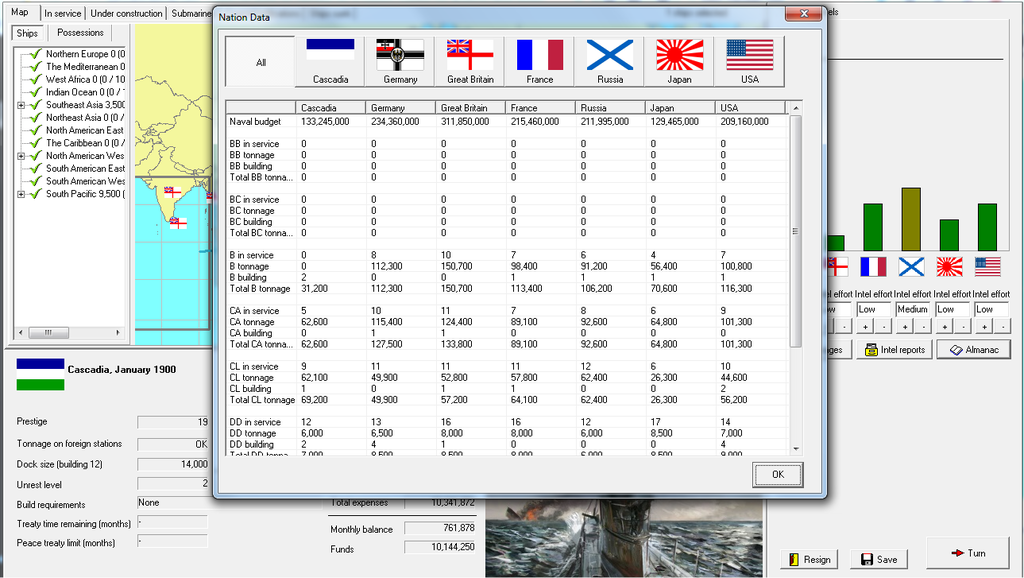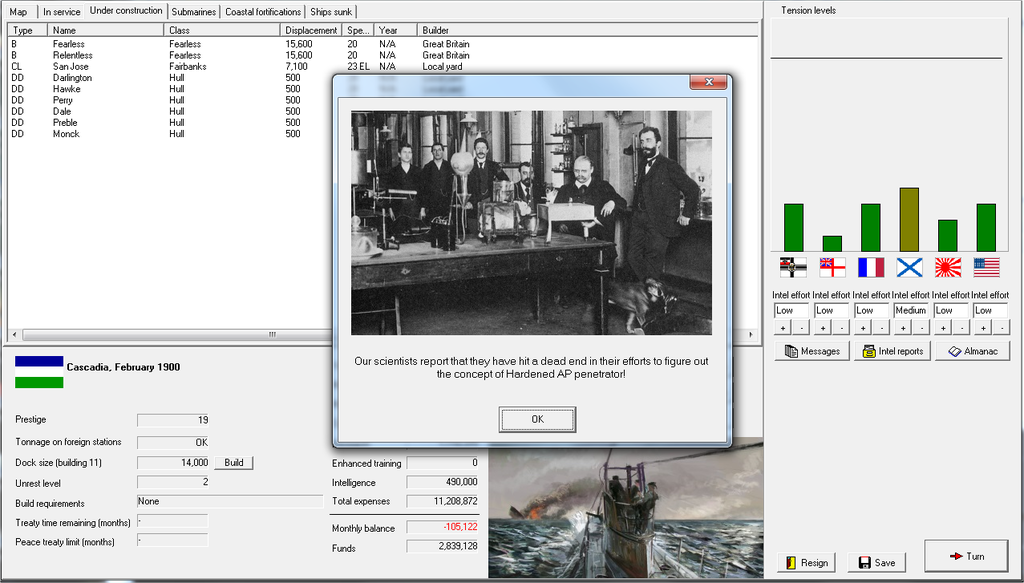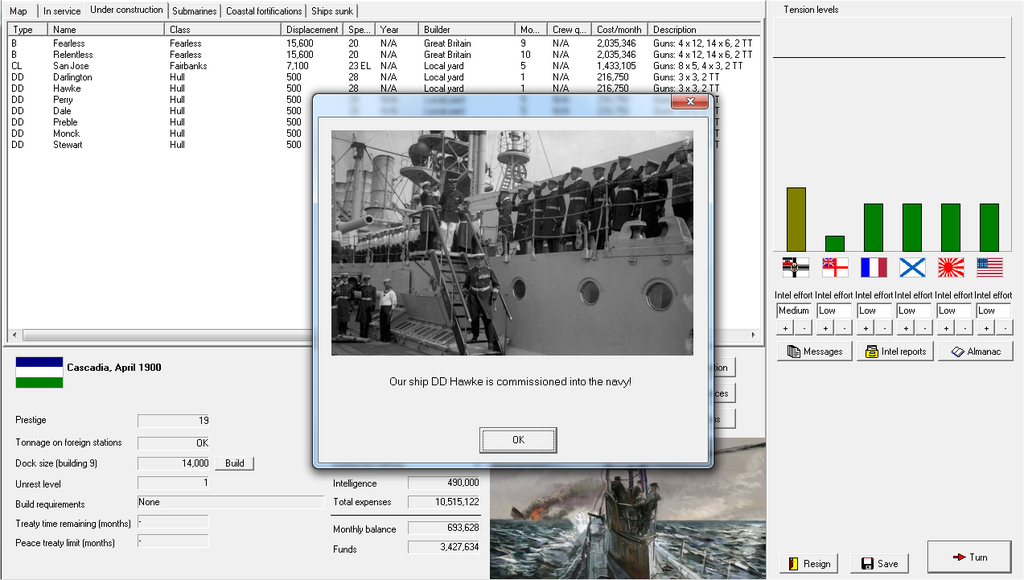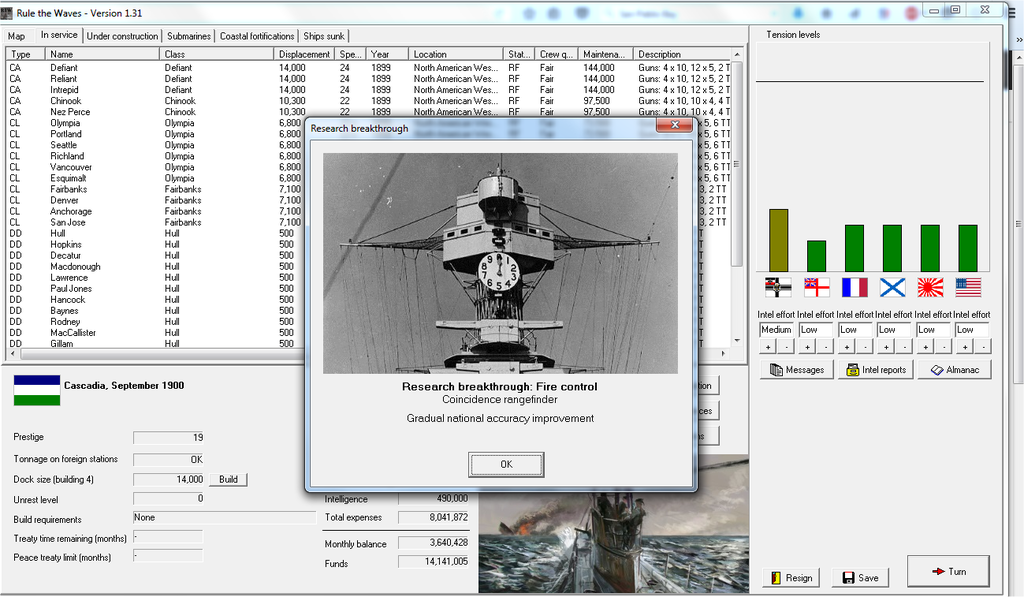Download Link to buy Rule The Waves is here.
Anyway, I'm cross-posting this from SB and SV. And as the title indicates, I made a Custom Country, which is not very difficult (arguably easier than custom countries in Paradox games without country designer features). Veterans of the SDN World games should not be surprised at what I picked.
I've tried to balance it starting position and progress to not be too difficult but not too easy either, and I've done about a dozen playthroughs with different aspects to fine-tune it. Albeit mostly in 1.22 and 1.26, I've only done two 1.3+ playthroughs so far. 1.3 has not entirely impressed me yet, if only because the new research rate option - while cool - seems to have reduced tech progression even at 100. Thankfully a quick edit to a save file can set it to something higher than 100, and I'll adjust it a bit over that mark to get a more reasonable tech rate in my view. (That, of course, is also a subjective matter, I'm sure others think the 100 tech rate is perfectly fine.
Now, as for my Custom Country, it is one I've played in the STGODs of SDN, and I do have an admittedly-unlikely alt-history for it that I started writing at one point, but I don't wish to bog down the thread with it so I will approach the ATL as such: I will reveal key alternate facts as they come up in the narrative of the game, or upon request of the readers.
However, I will give you a "brief" summation of the alterations:
In 1844, James K. Polk is nominated by the split Democratic Party to the American Presidency. In OTL, he beat Henry Clay. In this ATL, after his nomination he became ill and died before the election. The result completely upset all of the Democrats' hopes and Henry Clay won the Presidency. Clay was more interested in internal development than expansion and the Mexican-American War did not happen as historic; nor did the Oregon Treaty. Instead Britain and the US decided on another joint occupation treaty to decide the status of Oregon at a later date, while it remained open to settlement from both.
Fast forward to 1862. Despite the changes to the issue of Texan annexation and no expansion into New Mexico, the US Civil War still broke out over the issue of slavery in federal territories and other issues that put the Republicans on the map. At Shiloh, General Grant is injured severely in the first day of the fighting around, and on the second day the Union counter-attack falters and the Union Army is lucky to escape partially intact. This alters Lee's invasion of the North - due to the changed strategic situation - and the Lost Orders are never found, leading to Lee inflicting such a severe defeat on McClellan that the Army of the Potomac is nearly destroyed. Washington falls, and Confederate cavalry raiders attacking trains leaving the capital get a lucky shot... and mortally wound Abraham Lincoln.
Lincoln's death plunges the Union into despair and ensures an even greater Democratic victory in the 1862 midterms. Lord Russell's recommendations, and those of William Gladstone, Chancellor of the Exchequer, lead HM Government into recognizing the Confederacy, and Britain and France move to impose arbitration on the two sides.
Further acrimony between McClellan and Radical Republicans explodes into open social discontent. Anti-abolitionist and anti-black riots and demonstrations shake the North.
The South gets major Victory Disease and starts demanding excessive concessions from the North, concessions that even the British Government considers too much. Realizing that a Northern collapse would leave the Confederacy powerful enough to pursue an expansionist policy, one directly contradictory to British interests (including the renewed interest in restoring the trans-Atlantic Slave Trade in the South), Lord Palmerston engages in another maneuver. He offers the Union superior terms, and support against the Confederacy should they be rejected, in exchange for the Union agreeing to turn Oregon into an independent country. Britain would withdraw all but a small force to maintain a leased base at Esquimalt and the new nation, to be called Cascadia, would be under American and British protection. With the country's situation worsening and a Confederate army ready to march on Philadelphia should the Union not bow to the imperious demands of Richmond, the agreement is made. The Confederacy howls in defiance initially, but the sudden arrival of British squadrons off of key Confederate ports and the drying up of arms shipments from Europe allow Richmond moderates to prevail. The War Between the States ends in a compromise peace. West Virginia is restored to Virginia, but Maryland, Missouri, and Kentucky remain in the Union.
Meanwhile the new state of Cascadia works to found itself. The government seat is intentionally planned for the region of Puget Sound, but eventually Portland is made into the new Federal District, a triangle of territory between the Willamette and Columbia Rivers. The new nation's political system is a merger of the two countries; a President, elected by an Electoral College of internal Cascadian provinces, is Head of State and Government, but with an Executive Cabinet overseen by the Secretary of State in a watered down Prime Minister position with all Secretaries of the Federal Administration drawn from the Cascadian Parliamentary members of the Senate or the House of Representatives. A brief conspiracy by British royalist settlers attempts to seize the constitutional delegates and demand the acceptance of a monarchy - Victoria's third child and second son Prince Alfred was the preferred candidate, the OTL Duke of Edinburgh and of Saxe-Coburg and Gotha - but are foiled by the timely intervention of the Royal Navy and Marines under Admiral Baynes.
Cascadia gets an influx of settlers through the decade as abolitionists and black Americans flee the Union and the social unrest there. Unionists from Virginia and Tennessee also make their way to the west, either Cascadia or sparsely-protected Mexican California, while a Presidency under Clement L. Vallandigham continues to work to placate the South with concessions in hopes of restoring the Union.
Cascadia is barely given the chance to organize its fledgling forces when opportunity knocks. Emperor Maximilian and his French backers are mostly victorious in Mexico. With the Republican cause collapsing, the older and newer Anglo-American settlers in California, and local Republican officialdom, decide to turn to Cascadia for what support they can get. Recognizing the boon this would be, and with the okay from British authorities leery of French designs in North America, the Cascadian Army and militia sail with ships bought from Great Britain into San Francisco Harbor. The authorities in both Californias begin negotiation for joining the Cascadian Republic. Maximilian sends an army to oppose this effort. After early victories near Bakersfield and around Los Angeles, the Mexican Army ultimately meets its end at the Battle of the San Joaquin River, where the Cascadian troops - led by former Union officer General WIlliam Sherman - prevail. The Mexican Pacific Squadron sails north in an effort to support the army from the sea, where they in turn are defeated by the fledgling Cascadian Navy at the Battle of San Francisco Bay.
Finally, facing renewed Republican opposition in the heart of Mexico, Maximillian and Napoleon III agree to British arbitration, and in the Treaty of Guadalupe-Hidalgo Mexican territories north of the Gila and west of the Colorado are recognized as Cascadian territory. New Mexico becomes an independent country under joint protection in an effort to protect it from the aggressive Confederacy, which has already compelled Maximillian to accept the Texan claim of the Rio Grande up to El Paso as the southern border. He is further humiliated when the discoveries of valuable minerals in Nevada and California spar further immigration to Cascadia's newest territories, and provide the gold and silver to fund the Cascadian Miracle of the last quarter of the 19th Century.
Vallindigham's Presidency becomes a mockery after repeated Southern provocations go unchecked. At their apex the Southern fire-eaters, emboldened by their victory in the war, by Vallindigham's continued insistence that concessions to the South will eventually restore the Union, even go as far as to demand Kansas be turned over, that the Union by treaty allow slave-hunters into Union territory, while slave-traders plan slaving expeditions to Hispaniola. Resentment against the South overtakes the anti-abolitionist surge immediately after the war, and by 1872 the people of the Union have had enough. The Copperheads are crushed in the election and face severe popular discontent and a new, more aggressive Union government comes into being under Republican moderate Ulysses S. Grant, who is able to play up his part as the most successful Union general. The death of President Robert E. Lee to his age and infirmities removes a necessary moderating voice in Southern affairs in 1871.
In the late 1870s, Cascadia is in an economic boom as significant settlement continues and the population provides wildly fecund. Troubles with the Natives culminate in treaties that, while they do rob the Native Tribes of their autonomy and large sections of their land, nevertheless provide them with continued land rights better than anything they could get from the US Government. The economic boom helps fund the Riker-Gorchakov Treaty that sees Russian North America sold to Cascadia as the territory (and later province) of Alaska.
In 1880 the war breaks out, starting in New Mexico. The Confederacy, asserting Indian raids in Texas as provocation, invade New Mexico and overrun the Cascadian and Mexican defensive garrisons. Cascadia declares war and marches its armies into New Mexico. Seizing the opportunity, a provocation in Kentucky gives Grant's successor, James Garfield, pretext to deliver an ultimatum to the South. When it is refused, war is declared.
The Great North American War rages through the 1880s. Cascadia, after recovering New Mexico, swiftly integrates it into the Cascadian nation (the Mexican Empire, which failed to help protect the small state, is too wrought with internal divisions to protest effectively - a new Treaty of Sinaloa in 1886 sees the new borders recognized, with Cascadia getting a strip of land beyond the Giza down to the Gulf of California) and spends the rest of the war supporting Union forces in a slow, steady conquest of the South. The South's armies prove more show than effectiveness, their gallant martial charges and proud stands losing to the brutal arithmetic of artillery and the arrival of Sir Hiram Stevens Maxim's guns on the Union and Cascadian sides. With the Third French Republic and British Empire now hostile to the Confederacy, and the rest of Europe ambivalent, the Confederacy doesn't receive the necessary materials to resist the industrialized North and the heavily-industrializing Cascadians. By 1887, the South is conquered utterly and the Union declares the re-establishment of Federal authority. This sparks over a decade of vicious guerrilla warfare by Southern firebrands, supported by Cuban slave-owners, which inevitably results in the Spanish-American War.
In the meantime, Cascadian Marines had intervened on behalf of King David of Hawai'i in resisting his planters' attempts at a "Bayonet Constitution", the Cascadian officials reasoning that the planters would be a greater threat to Cascadian security in the east Pacific than a friendly monarch. The Treaty of Ford Island grants that island and neighboring naval portages to the Cascadian Navy in exchange for Cascadian military support for the Kingdom of Hawai'i and its independence.
In the south Pacific, Cascadian interests in Samoa, supporting King David and then Queen Lili'uokalani in their attempts at Polynesian political unity, yield a protectorate over Samoa, one fiercely opposed by the German Empire's growing desire for weltmacht.
The continued use of Cuba by Southern partisans finally explodes into a controversy and then, with the loss of the Maine in Havana Harbor, a war. Again Cascadia sided with the United States, although not without significant domestic discomfort and the clear antipathy of the British. The Cascadian Navy, now fielding state-of-the-art armored cruisers (the Defiant and her sisters Reliant and Intrepid) and under the command of Admiral Garrett, future Chief of Naval Procurement and then Chief of Naval Operations (Read: My in-game PC), sails against the Spanish Empire in the Pacific while the Union invades Cuba and Puerto Rico. At the Battle of Manila Bay the Spanish Pacific squadron is destroyed. A small reinforcement fleet flees with the aid of a storm instead of giving battle. Filipino insurgents join Cascadian troops taking Manila and destroying Spanish power in the Philippines.
In the Treaty of Paris of 1898, Cascadia presents its bill to Spain and the US; control of the Caroline Islands and recognition of the Philippine Republic. The United States annexed Spain's Caribbean holdings.
While some Cascadian leaders believed that the Philippines should be taken over, Ambrosio Rianzares Bautista and Emilio Aguinaldo had made it clear that the Philippines would fight Cascadia if it tried to assume dominion over the islands. The Cascadian government, under President John McGraw, recognized that it could not afford a prolonged war with the Filipinos and negotiated. In the end, the Treaty of Manila provided Cascadia basing rights in Manila Bay and authority to fortify the Bay and surrounding islands, in exchange providing military security to the new Republic.
In the aftermath of the war, there was an attempt to raise money through British banks to purchase the rest of the Spanish Pacific Empire. But an economic downturn spooked the British investors and the Spanish sold the Marianas to the German Empire instead.
Today Cascadia rules much of the Western third of North America, from the Arctic south to the Gila River and the Gulf of California. The eastern frontier of the country rises north from the US city of El Paso through the RL states of New Mexico and Colorado (Denver, Albuquerque, and Santa Fe are all in Cascadia), then along the US-held territory of Wyoming over to the 108th west meridian, then north along that meridian straight to the Arctic (with it being a border with Canada north of the 49th parallel). Cascadia also directly rules the islands of the Caroline chain directly, including naval bases at Chuuk Lagoon and Palau. The Kingdom of Hawai'i and the Republic of the Philippines are allies with military assistance and basing treaties. They are not full protectorates, but for the moment their governments find it easier to run foreign diplomacy in lock-step with Portland. Samoa is ruled by the Queen of Hawai'i.
Now.... that was a lot longer than I had intended.
Anyway, that is Cascadia. Now on to the actual game start.


Cascadia's stats are shown like this (and yes, the system hates custom countries' flags for some reason and cuts off the lower third). The bonuses of Cascadia I explain as following.
Attention To Detail, Efficient Shipbuilding, and the future employment of AoN armor are all tied to the same thing: Cascadia will be unlikely to ever enjoy parity with the European powers, not numerically. Thus the shipbuilding industry is focused on quality. Designs are carefully examined and management of shipyards is encouraged to practices to improve production efficiency, allowing the nation to get ships out more quickly than other powers.n When the time comes, the idea of using the AoN armor scheme is natural to a country seeking more efficient means to their navy, as it allows for a ship to have better protection with less tonnage by employing the armored citadel box.
Dock Size is at 14,000 tonnage.
In terms of guns, everything from 2 to 7 inch is at quality 0 and 8-12 is at quality -1... except for 10 inch guns, which are 0, and reflect Cascadia's cruiser-orientated fleet at game start. Additionally, the continued Cascadian desire for a strong cruising fleet due to the needs of Pacific power mean that the idea of employing super-imposing turrets on armored cruisers will be obvious once battlecruisers and battleships have proven the design concept.
(Note: Frankly speaking, CAs are not always an efficient design type to use in the second half of the game, so I didn't think it was very harmful or wanky to give this tech to reflect Cascadia's cruiser support. This is why Cascadia doesn't have Machinery Research advantage like I'd originally intended, as a trade-off.)
Anyway, now that we've got that out of the way...

Very Large fleet sizes, because I like big fleets and I cannot lie.
Admiral Garrett of course. For in-universe reasonableness, he will start as Chief of Naval Design and Procurement and rise from there, depending on how things go in the war to come. If anyone has any suggestions for the Vice CNO and CNO above him, shoot. If not, I'll make up more characters. This isn't as rigorous an althist as Cavalier's "Kaisertreu", obviously.
Select empty Save 5 slot and heeere we go....
Now, as for the first Cascadian designs in the game....
Cascadia starts the game with the following fleet:
12 Hull-class destroyer:

Unit Names: Hull, Hopkins, Decatur, Macdonough, Lawrence, Paul Jones, Hancock, Baynes, Rodney, MacCallister, Gillam, and Barnes. Darlington and Hawke are under construction.
I split the aft guns to either side in order to have two centreline mount torpedoes without sacrificing RoF.
3 Fairbanks-class protected cruiser:

Unit Names: Fairbanks, Denver, and Anchorage. San Jose is under construction.
Armed with 5" guns, these protected cruisers have huge coal fuel storage areas and with their 23 knot top speed are expected to bedevil enemy forces as commerce raiders.
Olympia-class protected cruiser:

Unit Names: Olympia, Portland, Seattle, Richland, Vancouver, Esquimalt
These protected cruisers were designed to help defend Cascadia's Polynesia holdings as well as act as protectors of the shipping lanes so vital to Cascadia's expanding economy and trans-Pacific trade routes. Their 7" armament and 5" secondary armament make them some of the most-heavily armed ships of their type in the world, but at the cost of only a 2" belt. (Note: If you try to go above that belt with 7" guns, the game forcefully re-designates your cruiser into a CA).
Chinook-class armored cruiser:

Unit Names: Chinook, Nez Perce.
The newest armored cruisers of the Cascadian Navy were built with a tighter budget in mind compared to their larger sisters, with only 22 knot speed, a smaller 4" secondary battery in casemates, and less protection. Future ships of the model were planned but scrapped by the naval budget of 1899 in favor of the Fearless-class battleships.
And finally, the pride of the Navy...
Defiant-class armored cruiser:

Unit Names: Defiant, Reliant, Intrepid
Considered by many to be the finest armored cruisers in the world, these vessels were built at great expense to be the pride of the fleet. Armed with the world's best 10" guns and a considerable secondary battery of 5" supported by 3" deck guns, armored to resist her own main guns - indeed, sufficiently armored to protect from long-range shellfire from battleship-grade guns - and with sufficient speed - at a blistering 24 knots - to run down the fastest protected cruisers afloat, these warships proved their worth by annihilating the Spanish Pacific Fleet at the Battle of Manila Bay.
Of course, for a nation becoming a known world power, the lack of a battle line became an embarrassment. So after the Spanish-American War, the Cascadian government cut short the order of Chinook-class armored cruisers and diverted the money to British shipbuilders for a new pair of battleships.
Fearless-class battleship

Unit Names: None in commission. Fearless and Relentless are under construction.
The beginnings of the Cascadian battle fleet are currently being constructed in the United Kingdom. Armed conventionally with 12" guns and a 6" secondary battery, these large warships will be the fastest battleships afloat at 20 knots, allowing them to dictate engagements against enemy battle lines.

Anyway, onto our opening map. You can see where Cascadia's holdings are in the Pacific (although "In-universe" Cascadia does not politically rule the Pacific islands marked, save for the Carolines. The Philippines are Hawai'i are allies who grant basing rights: Samoa is a protectorate controlled militarily by Cascadia and ruled indirectly by Hawai'i, with the Queen of Hawai'i also ruling as Queen of Samoa).
This first picture is before I set research to 10%, so my monthly balance will go down in later pictures.
Anyway, now on to the almanac.

Cascadia is sixth in naval spending, beating out only Japan. The AI likes to build crappy designs at game start, so it's no wonder that I'm last or near-last in most categories save for CLs, where I'm second in existing tonnage and lead in tonnage including that being built. But we'll see how things go if anyone goes to war with the Evergreen Republic...
And now on to research

As you can see, I've reduced priority to subs and ASW for the time being, focusing on machinery, fire control, ship design, and introducing new naval guns to my arsenals. Over time I will probably re-allocate. But I very much want Cascadia to be the first to field battlecruisers and ABG battleships (aka dreadnoughts). Time will tell if Admiral Garrett will get his way on this.
Now, before I commence the game, I have some writing to do. I wish to mix my methodology, and this will make the LP probably feel like a Battletech fluff book or some other RPG book. I will mix fluff bits - newspaper reports, speeches by politicians, etc. - with historical-sounding accounts and prose scenes of the movers and shakers of Cascadia and how they interact with Admiral Garrett in his quest to improve his nation's standing in the world, and make Cascadia the premier naval power of the Pacific Ocean.
It is my intention to end the game in 1930, if Garrett lasts that long, with an epilogue of his final retirement as of January 1st 1930 and a later epilogue, depending on how high his prestige is and how well Cascadia does in the three decades to come.
Anyway, as I write up our opening and then play our first few months of the game over this weekend, I look forward to your comments and suggestions. If you want to be Cascadian legislators or ship captains, feel free to submit your names for consideration.
And it'll be really fun when I start going further into the Cascadian destroyer names list. There are some... familiar names there.
(I did copy some, and then threw in the names of various British naval heroes or leading names. Hence Rodney and Hawke, among others.)















